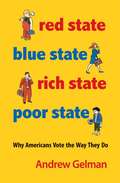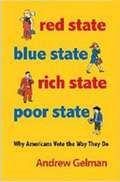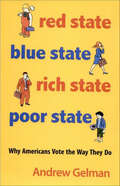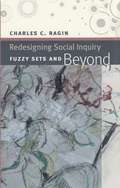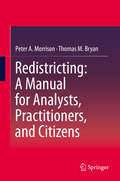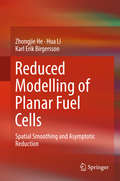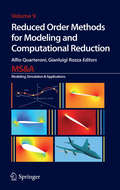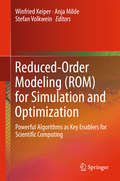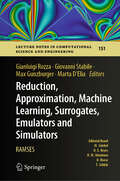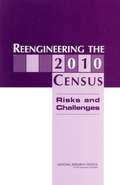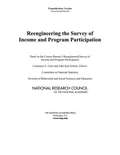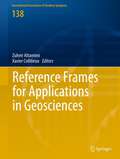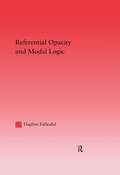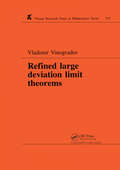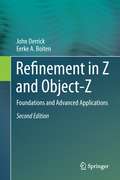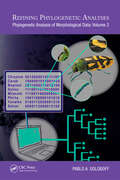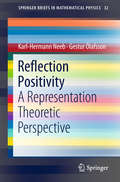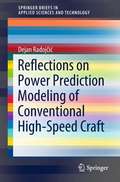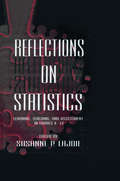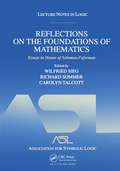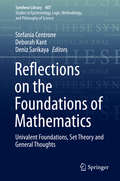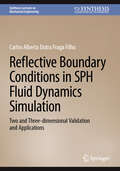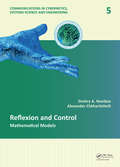- Table View
- List View
Red State, Blue State, Rich State, Poor State: Why Americans Vote the Way They Do
by Andrew Gelman David ParkOn the night of the 2000 presidential election, Americans watched on television as polling results divided the nation's map into red and blue states. Since then the color divide has become symbolic of a culture war that thrives on stereotypes--pickup-driving red-state Republicans who vote based on God, guns, and gays; and elitist blue-state Democrats woefully out of touch with heartland values. With wit and prodigious number crunching, Andrew Gelman debunks these and other political myths. This expanded edition includes new data and easy-to-read graphics explaining the 2008 election. Red State, Blue State, Rich State, Poor State is a must-read for anyone seeking to make sense of today's fractured political landscape.
Red State, Blue State, Rich State, Poor State: Why Americans Vote the Way They Do
by Jeronimo Cortina Andrew Gelman David Park Boris ShorOn the night of the 2000 presidential election, Americans sat riveted in front of their televisions as polling results divided the nation's map into red and blue states. Since then the color divide has become a symbol of a culture war that thrives on stereotypes--pickup-driving red-state Republicans who vote based on God, guns, and gays; and elitist, latte-sipping blue-state Democrats who are woefully out of touch with heartland values. Red State, Blue State, Rich State, Poor Statedebunks these and other political myths. With wit and prodigious number crunching, Andrew Gelman gets to the bottom of why Democrats win elections in wealthy states while Republicans get the votes of richer voters, how the two parties have become ideologically polarized, and other issues. Gelman uses eye-opening, easy-to-read graphics to unravel the mystifying patterns of recent voting, and in doing so paints a vivid portrait of the regional differences that drive American politics. He demonstrates in the plainest possible terms how the real culture war is being waged among affluent Democrats and Republicans, not between the haves and have-nots; how religion matters for higher-income voters; how the rich-poor divide is greater in red not blue states--and much more. Red State, Blue State, Rich State, Poor Stateis a must-read for anyone seeking to make sense of today's fractured American political landscape. Myths and facts about the red and the blue:Myth: The rich vote based on economics, the poor vote "God, guns, and gays. " Fact: Church attendance predicts Republican voting much more among rich than poor. Myth: A political divide exists between working-class "red America" and rich "blue America. " Fact: Within any state, more rich people vote Republican. The real divide is between higher-income voters in red and blue states. Myth: Rich people vote for the Democrats. Fact: George W. Bush won more than 60 percent of high-income voters. Myth: Religion is particularly divisive in American politics. Fact: Religious and secular voters differ no more in America than in France, Germany, Sweden, and many other European countries.
Red State, Blue State, Rich State, Poor State: Why Americans Vote the Way They Do
by Andrew GelmanOn the night of the 2000 presidential election, Americans watched on television as polling results divided the nation's map into red and blue states. Since then the color divide has become symbolic of a culture war that thrives on stereotypes--pickup-driving red-state Republicans who vote based on God, guns, and gays; and elitist blue-state Democrats woefully out of touch with heartland values. With wit and prodigious number crunching, Andrew Gelman debunks these and other political myths. This expanded edition includes new data and easy-to-read graphics explaining the 2008 election. Red State, Blue State, Rich State, Poor State is a must-read for anyone seeking to make sense of today's fractured political landscape.
Redesigning Social Inquiry: Fuzzy Sets and Beyond
by Charles C. RaginFor over twenty years Charles C. Ragin has been at the forefront of the development of innovative methods for social scientists. In Redesigning Social Inquiry, he continues his campaign to revitalize the field, challenging major aspects of the conventional template for social science research while offering a clear alternative. Redesigning Social Inquiry provides a substantive critique of the standard approach to social research- namely, assessing the relative importance of causal variables drawn from competing theories. Instead, Ragin proposes the use of set-theoretic methods to find a middle path between quantitative and qualitative research. Through a series of contrasts between fuzzy-set analysis and conventional quantitative research, Ragin demonstrates the capacity for set-theoretic methods to strengthen connections between qualitative researchers' deep knowledge of their cases and quantitative researchers' elaboration of cross-case patterns. Packed with useful examples,Redesigning Social Inquiry will be indispensable to experienced professionals and to budding scholars about to embark on their first project.
Redistricting: A Manual for Analysts, Practitioners, and Citizens
by Peter A. Morrison Thomas M. BryanThis comprehensive manual provides a user-oriented overview of U.S. Census data and demographic methods for redistricting applications. It addresses current issues and concerns accompanying the creation, adjustment, and evaluation of election districts and plans that incorporate them using 2020 Federal Census data. It meets the needs of local governments, citizen redistricting commissions, parties to litigation, and practitioners using Census data for political redistricting. The book provides many examples of technical problems that analysts will encounter when applying these data, supplemented by extensive case studies illustrating these technical issues and how they can be addressed. The book is a source to consult for insight, background, and concrete examples of specific issues and concerns and how to address them. As such this comprehensive reference manual is a "must have" for applied demographers, data scientists, statisticians, citizen redistricting commissions, parties to litigation, practitioners, and any analyst or organization engaged in political redistricting using US decennial census data.Prepublication quotes:“As a litigator who advises local governments on redistricting matters, this book is an essential resource.” John A. Safarli, Partner, Floyd, Pflueger & Ringer, P.S., Seattle, WA “A valuable primer for those who will participate in redistricting. Provides those new to the highly-charged work of drawing districts an understanding of what is at stake, what options exist and the pitfalls to avoid.” Professor Charles S. Bullock, III, University of Georgia (author of Redistricting: The Most Political Activity in America) “A meticulously researched, well-structured and informative foray into the nuts and bolts of the redistricting process. . .Will aid the bench and bar, public officials, and those elected and appointed citizens who are entrusted with the heavy responsibilities of redistricting from start to finish.Lives up to its name as a pragmatic guide for those involved in the redistricting process, be they demographic experts, statistical analysts, election law attorneys, litigants, or citizens involved in redistricting commissions. A resource for teaching election law and for defending governmental entities ensnared in the redistricting process.A must for anyone engaged in political redistricting based on the 2020 U.S. Census data.” Benjamin E. Griffith, Adjunct Professor of Election Law, University of Mississippi, Robert C. Khayat School of Law, and Principal in Griffith Law Firm, Oxford, Mississippi. (Editor and Author of America Votes! Challenges to Modern Election Law and Voting Rights, ABA Section of State & Local Government Law, 4th Ed., December 2019)
Redonda y redondo
by Cecilia AvalosLearn about round objects in this warmly illustrated book in Spanish.
Reduced Modelling of Planar Fuel Cells
by Hua Li Zhongjie He Karl Erik BirgerssonThis book focuses on novel reduced cell and stack models for proton exchange membrane fuel cells (PEMFCs) and planar solid oxide fuel cells (P-SOFCs) that serve to reduce the computational cost by two orders of magnitude or more with desired numerical accuracy, while capturing both the average properties and the variability of the dependent variables in the 3D counterparts. The information provided can also be applied to other kinds of plate-type fuel cells whose flow fields consist of parallel plain channels separated by solid ribs. These fast and efficient models allow statistical sensitivity analysis for a sample size in the order of 1000 without prohibitive computational cost to be performed to investigate not only the individual, but also the simultaneous effects of a group of varying geometrical, material, and operational parameters. This provides important information for cell/stack design, and to illustrate this, Monte Carlo simulation of the reduced P-SOFC model is conducted at both the single-cell and stack levels.
Reduced Order Methods for Modeling and Computational Reduction
by Gianluigi Rozza Alfio QuarteroniThis monograph addresses the state of the art of reduced order methods for modeling and computational reduction of complex parametrized systems, governed by ordinary and/or partial differential equations, with a special emphasis on real time computing techniques and applications in computational mechanics, bioengineering and computer graphics. Several topics are covered, including: design, optimization, and control theory in real-time with applications in engineering; data assimilation, geometry registration, and parameter estimation with special attention to real-time computing in biomedical engineering and computational physics; real-time visualization of physics-based simulations in computer science; the treatment of high-dimensional problems in state space, physical space, or parameter space; the interactions between different model reduction and dimensionality reduction approaches; the development of general error estimation frameworks which take into account both model and discretization effects. This book is primarily addressed to computational scientists interested in computational reduction techniques for large scale differential problems.
Reduced-Order Modeling (ROM) for Simulation and Optimization
by Winfried Keiper Anja Milde Stefan VolkweinThis edited monograph collects research contributions and addresses the advancement of efficient numerical procedures in the area of model order reduction (MOR) for simulation, optimization and control. The topical scope includes, but is not limited to, new out-of-the-box algorithmic solutions for scientific computing, e.g. reduced basis methods for industrial problems and MOR approaches for electrochemical processes. The target audience comprises research experts and practitioners in the field of simulation, optimization and control, but the book may also be beneficial for graduate students alike.
Reducing Response Burden in the American Community Survey: Proceedings of a Workshop
by Engineering Medicine National Academies of SciencesAlthough people in the United States have historically been reasonably supportive of federal censuses and surveys, they are increasingly unavailable for or not willing to respond to interview requests from federal—as well as private—sources. Moreover, even when people agree to respond to a survey, they increasingly decline to complete all questions, and both survey and item nonresponse are growing problems. In March 2016, the National Academies of Sciences, Engineering, and Medicine convened a workshop to consider the respondent burden and its challenges and opportunities of the American Community Survey, which is conducted by the U.S. Census Bureau. This publication summarizes the presentations and discussions from the workshop.
Reduction, Approximation, Machine Learning, Surrogates, Emulators and Simulators: RAMSES (Lecture Notes in Computational Science and Engineering #151)
by Gianluigi Rozza Max Gunzburger Marta D'Elia Giovanni StabileThis volume is focused on the review of recent algorithmic and mathematical advances and the development of new research directions for Mathematical Model Approximations via RAMSES (Reduced order models, Approximation theory, Machine learning, Surrogates, Emulators, Simulators) in the setting of parametrized partial differential equations also with sparse and noisy data in high-dimensional parameter spaces. The book is a valuable resource for researchers, as well as masters and Ph.D students.
Reengineering the 2010 Census: Risks and Challenges
by Panel on Research on Future Census MethodsAt the request of the U.S. Census Bureau, the National Research Council's Committee on National Statistics established the Panel on Research on Future Census Methods to review the early planning process for the 2010 census. <P><P>This new report documents the panel's strong support for the major aims of the Census Bureau's emerging plan for 2010. At the same time, it notes the considerable challenges that must be overcome if the bureau's innovations are to be successful. The panel agrees with the Census Bureau that implementation of the American Community Survey and, with it, the separation of the long form from the census process are excellent concepts. <P><P>Moreover, it concurs that the critically important Master Address File and TIGER geographic systems are in dire need of comprehensive updating and that new technologies have the potential to improve the accuracy of the count. <P><P>The report identifies the risks and rewards of these and other components of the Census Bureau's plan. The report emphasizes the need for the bureau to link its research and evaluation efforts much more closely to operational planning and the importance of funding for a comprehensive and rigorous testing program before 2010.
Reengineering the Survey of Income and Program Participation
by National Research Council of the National AcademiesBeginning in 2006, the Census Bureau embarked on a program to reengineer the Survey of Income and Program Participation (SIPP) to reduce its costs and improve data quality and timeliness. The Bureau also requested the National Academies to consider the advantages and disadvantages of strategies for linking administrative records and survey data, taking account of the accessibility of relevant administrative records, the operational feasibility of linking, the quality and usefulness of the linked data, and the ability to provide access to the linked data while protecting the confidentiality of individual respondents. In response, this volume first examines the history of SIPP and reviews the survey's purpose, value, strengths, and weaknesses. The book examines alternative uses of administrative records in a reengineered SIPP and, finally, considers innovations in SIPP design and data collection, including the proposed use of annual interviews with an event history calendar.
Reference Frames for Applications in Geosciences
by Xavier Collilieux Zuheir AltamimiReference systems and frames are of primary importance for many Earth science applications, satellite navigation as well as for practical applications in geo-information. A precisely defined reference frame is needed for the quantification of, e.g. Earth rotation and its gravity field, global and regional sea level variation, tectonic motion and deformation, post-glacial rebound, geocenter motion, large scale deformation due to Earthquakes, local subsidence and other ruptures and crustal dislocations. All of these important scientific applications fundamentally depend on a truly global reference system that only space geodesy can realize. This volume details the proceedigns of the IAG Symposium REFAG2010 (Marne la Vallée, France, October 4-8, 2010) The primary scope of REFAG2010 was to address today's achievements on theoretical concepts of reference systems and their practical implementations by individual space geodetic techniques and their combinations, underlying limiting factors, systematic errors and novel approaches for future improvements.
Referential Opacity and Modal Logic
by Dagfinn FollesdalThis landmark dissertation (1961) provides a systematic introduction to systems of modal logic and stands as the first presentation of what have become central ideas in philosophy of language and metaphysics, from the 'new theory of reference' and non-linguistic necessity and essentialism to 'Kripke semantics'.
Refined Large Deviation Limit Theorems
by Vladimir VinogradovThis is a developing area of modern probability theory, which has applications in many areas. This volume is devoted to the systematic study of results on large deviations in situations where Cramér's condition on the finiteness of exponential moments may not be satisfied
Refinement in Z and Object-Z: Foundations and Advanced Applications
by Eerke A. Boiten John DerrickRefinement is one of the cornerstones of the formal approach to software engineering, and its use in various domains has led to research on new applications and generalisation. This book brings together this important research in one volume, with the addition of examples drawn from different application areas. It covers four main themes: Data refinement and its application to ZGeneralisations of refinement that change the interface and atomicity of operationsRefinement in Object-ZModelling state and behaviour by combining Object-Z with CSPRefinement in Z and Object-Z: Foundations and Advanced Applications provides an invaluable overview of recent research for academic and industrial researchers, lecturers teaching formal specification and development, industrial practitioners using formal methods in their work, and postgraduate and advanced undergraduate students. This second edition is a comprehensive update to the first and includes the following new material: Early chapters have been extended to also include trace refinement, based directly on partial relations rather than through totalisationProvides an updated discussion on divergence, non-atomic refinements and approximate refinementIncludes a discussion of the differing semantics of operations and outputs and how they affect the abstraction of models written using Object-Z and CSPPresents a fuller account of the relationship between relational refinement and various models of refinement in CSPBibliographic notes at the end of each chapter have been extended with the most up to date citations and research
Refining Phylogenetic Analyses: Phylogenetic Analysis of Morphological Data: Volume 2 (Species and Systematics)
by Pablo A. GoloboffThis volume discusses the aspects of a phylogenetic analysis that go beyond basic calculation of most parsimonious trees. Practical application of all principles discussed is illustrated by reference to TNT, a freely available software package that can perform all the steps needed in a phylogenetic analysis. The first problem considered is how to summarize and compare multiple trees (including identification and handling wildcard taxa). Evaluation of the strength of support for groups, another critical component of any phylogenetic analysis, is given careful consideration. The different interpretations of measures of support are discussed and connected with alternative implementations. The book reviews rationales for estimating character reliability on the basis of homoplasy, with particular attention to morphological characters. The main methods for character weighting and their practical implementation, several of them unique to TNT, are discussed ad libitum. Also unique to TNT is the ability to directly analyze morphometric data (including landmarks), on the same footing as discrete characters. Finally, the scripting language of TNT is introduced. With scripting, it is possible to "program" TNT to create personalized routines and automate complex calculations, taking analyses to the next level and allowing exploration of new methods and ideas.Key Features Discusses the treatment of ambiguity in phylogenetic analyses in depth, for summarizing results or comparing trees Reviews literature on arguments and methods for weighting morphological characters and their practical application Describes theory and application of methods for evaluating strength of group support, based on either resampling or comparisons with suboptimal trees Discusses the use of morphometric characters in phylogenetic analysis Presents extensive information on commands and options of the TNT computer program, including the use and creation of scripts
Reflection Positivity: A Representation Theoretic Perspective (SpringerBriefs in Mathematical Physics #32)
by Karl-Hermann Neeb Gestur ÓlafssonRefection Positivity is a central theme at the crossroads of Lie group representations, euclidean and abstract harmonic analysis, constructive quantum field theory, and stochastic processes.This book provides the first presentation of the representation theoretic aspects of Refection Positivity and discusses its connections to those different fields on a level suitable for doctoral students and researchers in related fields.It starts with a general introduction to the ideas and methods involving refection positive Hilbert spaces and the Osterwalder--Schrader transform. It then turns to Reflection Positivity in Lie group representations. Already the case of one-dimensional groups is extremely rich.For the real line it connects naturally with Lax--Phillips scattering theory and for the circle group it provides a new perspective on the Kubo--Martin--Schwinger (KMS) condition for states of operator algebras. For Lie groups Reflection Positivity connects unitary representations of a symmetric Lie group with unitary representations of its Cartan dual Lie group.A typical example is the duality between the Euclidean group E(n) and the Poincare group P(n) of special relativity. It discusses in particular the curved context of the duality between spheres and hyperbolic spaces. Further it presents some new integration techniques for representations of Lie algebras by unbounded operators which are needed for the passage to the dual group. Positive definite functions, kernels and distributions and used throughout as a central tool.
Reflections on Power Prediction Modeling of Conventional High-Speed Craft (SpringerBriefs in Applied Sciences and Technology)
by Dejan RadojčićThis SpringerBrief focuses on modeling and power evaluation of high-speed craft. The various power prediction methods, a principal design objective for high-speed craft of displacement, semi-displacement, and planing type, are addressed. At the core of the power prediction methods are mathematical models for resistance and propulsion efficiency. The models are based on the experimental data of various high-speed hull and propeller series. The regression analysis and artificial neural network (ANN) methods are used as an extraction tool for this kind of mathematical models. A variety of mathematical models of this type are discussed in the book.Once these mathematical models have been developed and validated, they can be readily programmed into software tools, thereby enabling the parametric analyses required for the optimization of a high-speed craft design. This book provides the foundational reference for these software tools, and their use in the design of high-speed craft. High-speed craft are very different from conventional ships. Current professional literature leaves a gap in the documentation of best design practices for high-speed craft. This book is aimed at naval architects who design and develop various types of high-speed vessels.
Reflections on Statistics: Learning, Teaching, and Assessment in Grades K-12 (Studies in Mathematical Thinking and Learning Series)
by Susanne P. LajoieAn issue in the current push for reform in mathematics education is the call to address statistics at the precollege level. This volume represents the emerging findings of an interdisciplinary collaboration among a group of mathematics educators, cognitive scientists, teachers, and statisticians to construct an understanding of how to introduce statistics education and assessment for students in elementary and secondary schools. A premise shared by the contributors to this volume is that when students are introduced to statistics at the K-12 level and provided with opportunities to do statistics that are related to actual life situations, they will be better prepared for decision making in the real world. The interdisciplinary nature of the group of researchers stimulated a lively interchange of ideas for enhancing the learning, teaching, and assessment of statistical understanding, which is reflected in this volume. Mathematics educators contribute their insights into how teachers teach mathematical ideas and heighten our awareness of the ecological needs of the current mathematics classroom. Cognitive scientists share their understanding of developmental differences in learning and present theoretical perspectives that contribute to the design of effective learning environments. Classroom teachers share their ideas about classroom activities and assessment of student learning, as well as their concerns for in-service training and workshops to help teachers acquire skills in this new content area. Statisticians offer their understanding of what is feasible to teach in the early grades, and what their view is of statistical literacy. The book is organized around four interdependent themes: content, teaching, learning, and assessment. By focusing their respective chapters on particular themes, the authors intend to cultivate a better understanding of how each relates to improvements in statistics education. This is the first book to: * address statistics learning in grades K-12, * address issues of statistical curriculum content in grades K-12, * address issues of assessment of statistics learning in grades K-12, * bring issues of technology instruction and assessment in statistics education in grades K-12, and * look at teacher education for statistics instruction in grades K-12. This is a must-read book for both practitioners and researchers involved in K-12 mathematics education.
Reflections on the Foundations of Mathematics: Lecture Notes in Logic 15
by Carolyn Talcott Wilfried Sieg Richard SommerSolomon Feferman has shaped the field of foundational research for nearly half a century. These papers, most of which were presented at the symposium honoring him at his 70th birthday, reflect his broad interests as well as his approach to foundational research, which places the solution of mathematical and philosophical problems at the top of his
Reflections on the Foundations of Mathematics: Univalent Foundations, Set Theory and General Thoughts (Synthese Library #407)
by Stefania Centrone Deborah Kant Deniz SarikayaThis edited work presents contemporary mathematical practice in the foundational mathematical theories, in particular set theory and the univalent foundations. It shares the work of significant scholars across the disciplines of mathematics, philosophy and computer science. Readers will discover systematic thought on criteria for a suitable foundation in mathematics and philosophical reflections around the mathematical perspectives.The volume is divided into three sections, the first two of which focus on the two most prominent candidate theories for a foundation of mathematics. Readers may trace current research in set theory, which has widely been assumed to serve as a framework for foundational issues, as well as new material elaborating on the univalent foundations, considering an approach based on homotopy type theory (HoTT). The third section then builds on this and is centred on philosophical questions connected to the foundations of mathematics. Here, the authors contribute to discussions on foundational criteria with more general thoughts on the foundations of mathematics which are not connected to particular theories.This book shares the work of some of the most important scholars in the fields of set theory (S. Friedman), non-classical logic (G. Priest) and the philosophy of mathematics (P. Maddy). The reader will become aware of the advantages of each theory and objections to it as a foundation, following the latest and best work across the disciplines and it is therefore a valuable read for anyone working on the foundations of mathematics or in the philosophy of mathematics.
Reflective Boundary Conditions in SPH Fluid Dynamics Simulation: Two and Three-dimensional Validation and Applications (Synthesis Lectures on Mechanical Engineering)
by Carlos Alberto Fraga FilhoThis book presents results from applying Reflective Boundary Conditions (RBC) in particle simulations coupled with the Smoothed Particle Hydrodynamics (SPH) Method in two- and three-dimensional domains. The contribution of this work lies in the presentation of the state of the art regarding the application of physical and realistic boundary conditions in the continuum domain, which is an advance in the artificial computational boundary treatment carried out in most SPH simulations. By reading this work, researchers from different fields dealing with Computational Fluid Dynamics (CFD) will be aware of the most recent results of applying the SPH method coupled with RBC, confirming its scientific validity and encouraging its implementation in other problems. This multidisciplinary work is aimed at undergraduate and postgraduate students, researchers, software developers, and other engineering, physics, chemistry, mathematics, and related sciences professionals.
Reflexion and Control: Mathematical Models (Communications in Cybernetics, Systems Science and Engineering)
by Dmitry A. Novikov Alexander G. ChkhartishviliThis book is dedicated to modern approaches to mathematical modeling of reflexive processes in control. The authors consider reflexive games that describe the gametheoretical interaction of agents making decisions based on a hierarchy of beliefs regarding (1) essential parameters (informational reflexion), (2) decision principles used by opponents
